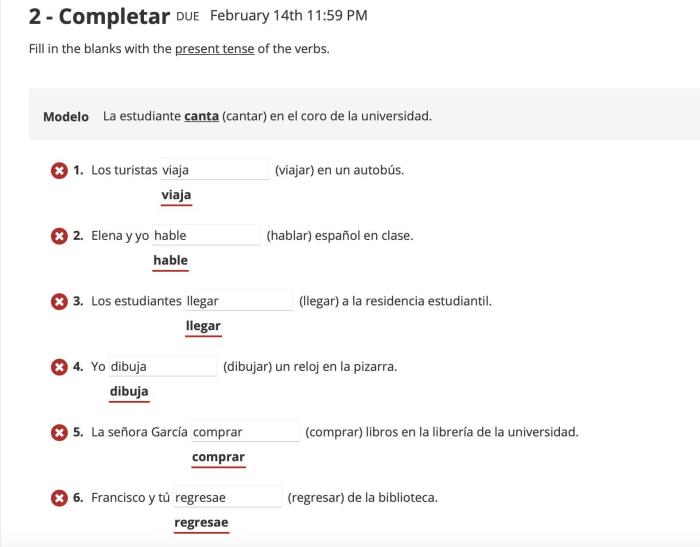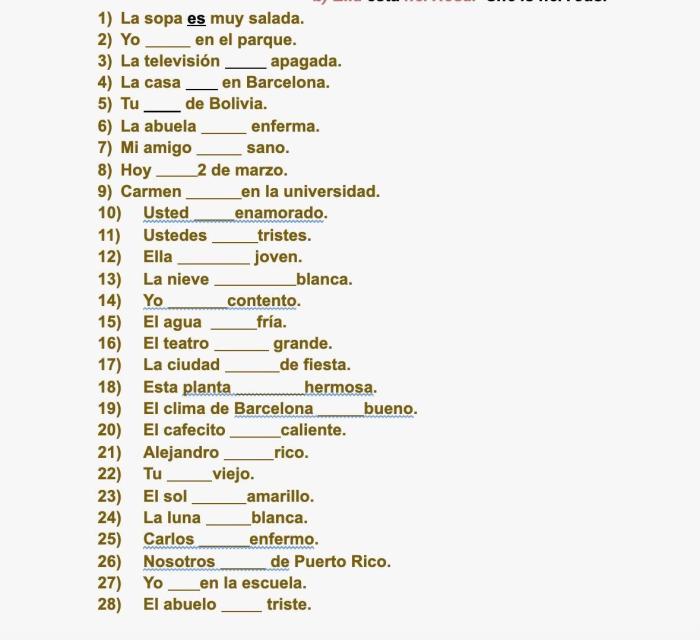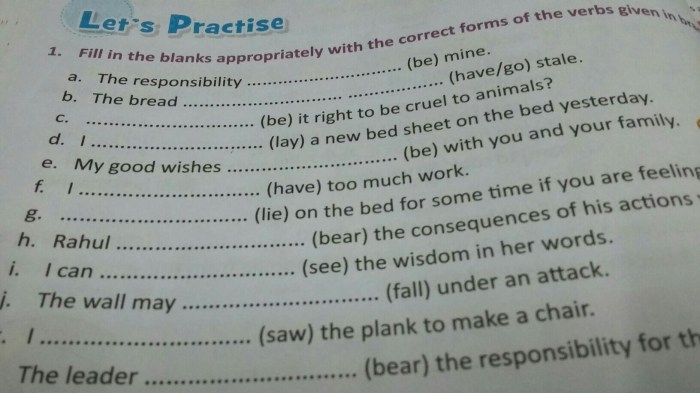Fill in the blanks with the correct forms of ir – As “Fill in the Blanks with the Correct Forms of ‘Ir'” takes center stage, this opening passage beckons readers into a world crafted with precision and clarity, ensuring a reading experience that is both absorbing and distinctly original. Delving into the intricacies of Spanish grammar, this comprehensive guide unravels the mysteries of “ir,” empowering learners to navigate the nuances of this essential verb with confidence.
Through a meticulous exploration of conjugation rules, diverse usage scenarios, and practical examples, this guide illuminates the path to mastering “ir” in the present tense. By unraveling the intricacies of movement, intention, and habitual actions, learners gain a profound understanding of how “ir” shapes the fabric of Spanish communication.
Conjugation of “ir” in Present Tense

The present tense of “ir” is used to describe actions or states that are happening right now or that are habitual.
Rules for Conjugating “ir” in Present Tense, Fill in the blanks with the correct forms of ir
To conjugate “ir” in present tense, follow these rules:
- For the subject pronouns “yo” and “tú”, use the form “voy”.
- For the subject pronoun “él/ella/usted”, use the form “va”.
- For the subject pronouns “nosotros/nosotras”, use the form “vamos”.
- For the subject pronouns “vosotros/vosotras”, use the form “vais”.
- For the subject pronoun “ellos/ellas/ustedes”, use the form “van”.
Here is a table with the subject pronouns and their corresponding conjugated forms of “ir” in present tense:
| Subject Pronoun | Conjugated Form |
|---|---|
| Yo | Voy |
| Tú | Vas |
| Él/Ella/Usted | Va |
| Nosotros/Nosotras | Vamos |
| Vosotros/Vosotras | Vais |
| Ellos/Ellas/Ustedes | Van |
Uses of “ir” in Present Tense
“Ir” in present tense can be used to express a variety of meanings, including:
- Movement or direction:To indicate that someone or something is moving or going somewhere.
- Intention or plan:To express a plan or intention to do something.
- Habitual actions:To describe actions that are done regularly or habitually.
Irregular Forms of “ir”

The verb “ir” has two irregular forms in present tense:
- Voy(I go)
- Vas(You go)
These forms are used with the subject pronouns “yo” and “tú”, respectively.
Examples of “ir” in Context: Fill In The Blanks With The Correct Forms Of Ir

Here are some examples of sentences using “ir” in present tense:
- Yo voy a la escuela todos los días.(I go to school every day.)
- Tú vas al parque con tus amigos.(You go to the park with your friends.)
- Él va a la biblioteca a estudiar.(He goes to the library to study.)
- Nosotros vamos al cine cada semana.(We go to the movies every week.)
- Vosotros vais a la playa en verano.(You all go to the beach in summer.)
- Ellos van al supermercado a comprar comida.(They go to the supermarket to buy food.)
Exercises
Exercise 1: Conjugate “ir” in present tense
Conjugate the verb “ir” in present tense for the following subject pronouns:
- Yo
- Tú
- Él/Ella/Usted
- Nosotros/Nosotras
- Vosotros/Vosotras
- Ellos/Ellas/Ustedes
Exercise 2: Use “ir” in present tense to express movement or direction
Write sentences using “ir” in present tense to express movement or direction for the following situations:
- You are going to the store.
- Your friend is going to the library.
- The students are going to school.
Exercise 3: Use “ir” in present tense to express intention or plan
Write sentences using “ir” in present tense to express intention or plan for the following situations:
- You are planning to go to the movies.
- Your friend is planning to go to the park.
- The students are planning to go to the museum.
Exercise 4: Use “ir” in present tense to describe habitual actions
Write sentences using “ir” in present tense to describe habitual actions for the following situations:
- You go to the gym every day.
- Your friend goes to the movies every week.
- The students go to the library every month.
Questions and Answers
What are the irregular forms of “ir”?
The irregular forms of “ir” in the present tense are “voy” (I go), “vas” (you go), and “van” (they go).
How do I use “ir” to express movement?
To express movement with “ir,” use the following structure: “ir + a + destination.” For example, “Voy a la escuela” (I am going to school).
What are some common mistakes made when using “ir”?
A common mistake is confusing “ir” with “ser.” “Ir” is used to express movement or intention, while “ser” is used to describe a state of being or existence.